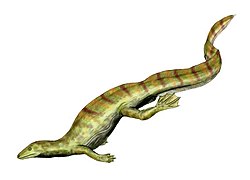Top Qs
Timeline
Chat
Perspective
Eosuchia
Extinct order of reptiles From Wikipedia, the free encyclopedia
Remove ads
Eosuchians are an extinct order of diapsid reptiles. Depending on which taxa are included the order may have ranged from the late Carboniferous to the Eocene but the consensus is that eosuchians are confined to the Permian and Triassic[citation needed].
Eosuchia was initially defined to include all "thecodontian" reptiles which did not have an antorbital fenestra but did retain tabulars, postparietals and a large pineal foramen (Broom, 1914). Broom coined the term as a new suborder for Youngina.
A definition for inclusion in the order is difficult: it is almost easier to list the primitively-diapsid reptiles that have not been included at one time or another. The order has almost been treated as a dustbin for diapsids that are not obviously lepidosaurian or archosaurian. One consequence has been Romer's suggestion of the alternative order Younginiformes to be applied strictly to those forms with the primitive diapsid form, in particular, a complete lowermost arch as the quadratojugal and jugal bones of the skull meet.[1]
The one constant eosuchian has been Youngina, a small lizard-shaped reptile from the Upper Permian of South Africa. This and a couple of other genera make up the family Younginidae.
The tangasaurids, a family that includes forms apparently adapted for swimming in fresh water, is also usually included.[2]
In some phylogenies Eosuchia has been treated (probably erroneously) as a sister lepidosaur taxon to Squamata and Rhynchocephalia.[3]
Remove ads
Classification
Eosuchia s.s. (Syn:Younginiformes)
- Family incertae sedis
- Family: Galesphyridae
- Galesphyrus
- Family: Younginidae
- Family: Tangasauridae
References
Wikiwand - on
Seamless Wikipedia browsing. On steroids.
Remove ads

